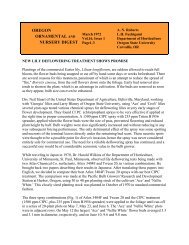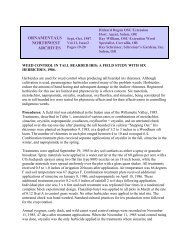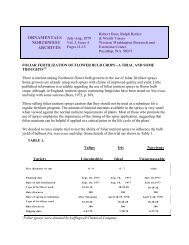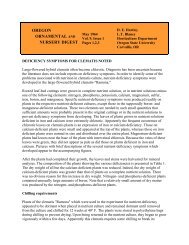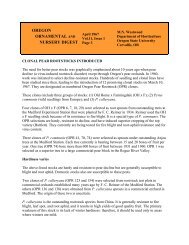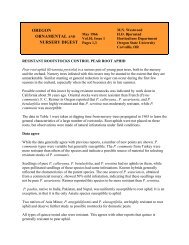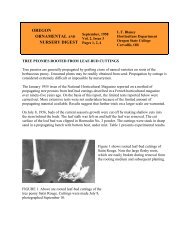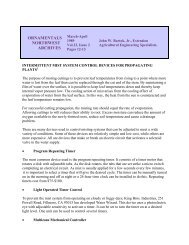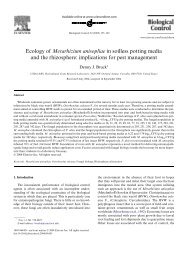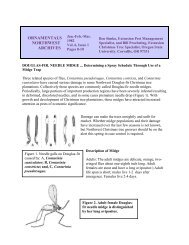Spraying Leaves of Pear Nursery Trees with Urea and Copper ...
Spraying Leaves of Pear Nursery Trees with Urea and Copper ...
Spraying Leaves of Pear Nursery Trees with Urea and Copper ...
You also want an ePaper? Increase the reach of your titles
YUMPU automatically turns print PDFs into web optimized ePapers that Google loves.
RESEARCH REPORTS<br />
1986; Pscheidt <strong>and</strong> Ocamb, 2002).<br />
Recently, growers <strong>of</strong> pear nursery trees<br />
in the PNW have reported increased<br />
incidence <strong>and</strong> severity <strong>of</strong> damage to<br />
trees by P. syringae when ‘Old Home ·<br />
Farmington 97’ pear (‘OHF 97’) rootstock<br />
is sprayed <strong>with</strong> urea <strong>and</strong> chemical<br />
defoliants. It was hypothesized that<br />
the combination <strong>of</strong> urea <strong>and</strong> defoliant<br />
treatment predisposes the trees to<br />
P. syringae infection by inflicting injury<br />
to the stem tissue or by indirectly making<br />
the trees more susceptible to infection<br />
by increasing tree N content.<br />
With other plant pathogens, abundant<br />
N can make trees more susceptible<br />
to pathogens <strong>and</strong> increase the length<br />
<strong>of</strong> time trees are more susceptible<br />
(Frecon, 1982; Simon et al., 2003).<br />
Infection <strong>of</strong> bare-rooted nursery<br />
trees by P. syringae during cold storage<br />
could result from subjecting trees<br />
to environmental conditions that favor<br />
the growth <strong>of</strong> the pathogen <strong>and</strong>/<br />
or are unfavorable to maintaining optimal<br />
physiological condition <strong>of</strong> the<br />
plant (Pscheidt <strong>and</strong> Ocamb, 2002).<br />
The combination <strong>of</strong> host predisposition<br />
<strong>and</strong> cold, wet conditions in cold<br />
storage or outdoors favorable for pathogen<br />
activity increases the potential<br />
for disease. In addition, P. syringae infection<br />
might be favored by the physiological<br />
or physical condition <strong>of</strong> the<br />
plant during harvesting <strong>and</strong> subsequent<br />
h<strong>and</strong>ling <strong>and</strong> storage. It is possible<br />
that trees harvested before they<br />
are dormant may be more susceptible<br />
to P. syringae <strong>and</strong> that surface wounds<br />
or leaf scars resulting from urea <strong>and</strong><br />
defoliant sprays <strong>and</strong> harvesting <strong>and</strong><br />
h<strong>and</strong>ling procedures could also serve<br />
as infection openings for P. syringae.<br />
Increased damage by P. syringae<br />
has not been reported for the majority<br />
<strong>of</strong> plant species that are sprayed <strong>with</strong><br />
urea <strong>and</strong> defoliants during production.<br />
Some nurserymen report that<br />
early defoliation <strong>of</strong> trees treated <strong>with</strong><br />
the combination <strong>of</strong> urea <strong>and</strong> defoliant<br />
may actually reduce the incidence or<br />
severity <strong>of</strong> diseases (L. Lyon, personnel<br />
communication). Reduced disease incidence<br />
<strong>and</strong> severity in response to<br />
early defoliation may be a result <strong>of</strong><br />
more complete healing <strong>of</strong> leaf scars<br />
before the cold, wet conditions in<br />
the autumn when the potential for<br />
P. syringae infection is high. Additionally,<br />
early defoliation enables trees to<br />
be harvested <strong>and</strong> stored before the onset<br />
<strong>of</strong> environmental conditions that<br />
promote the activity <strong>and</strong> subsequent<br />
infection by P. syringae (Bostock <strong>and</strong><br />
Doster, 1985). The effect <strong>of</strong> urea <strong>and</strong><br />
defoliants on disease incidence <strong>and</strong><br />
severity caused by P. syringae appears<br />
to be species specific <strong>and</strong> may be related<br />
to the time autumn sprays are<br />
used during production.<br />
Common control measures for<br />
P. syringae in nursery production include<br />
a combination <strong>of</strong> good nursery<br />
sanitation practices <strong>and</strong> chemical application.<br />
Phosphonate-containing fungicides,<br />
including fosetyl-aluminum<br />
(fosetyl-Al) <strong>and</strong> its breakdown product,<br />
phosphorous acid (also referred<br />
to as phosphonate) are commonly<br />
used to control Phytophthora species<br />
(Doster <strong>and</strong> Bostock, 1988; Erwin <strong>and</strong><br />
Ribeiro, 1996). It is applied to trees as<br />
sprays, drenches, dips, or by injection<br />
(Erwin <strong>and</strong> Ribeiro, 1996; Pegg<br />
et al., 1987; Quimete <strong>and</strong> C<strong>of</strong>fey,<br />
1989; Tidball <strong>and</strong> Linderman, 1990).<br />
Fosetyl-Al translocates upward <strong>and</strong><br />
downward (in the transpiration stream<br />
<strong>and</strong>inthephloemsap)<strong>and</strong>mayhave<br />
direct fungal toxicity activity against<br />
Phytophthora species, or induces host<br />
plant resistance (Erwin <strong>and</strong> Ribeiro,<br />
1996). Although chemical control<br />
measures exist for this pathogen, the<br />
influence <strong>of</strong> these chemicals on controlling<br />
the disease may be affected<br />
by the use <strong>of</strong> urea <strong>and</strong> defoliant sprays<br />
during nursery production.<br />
Our specific objectives were to<br />
determine whether susceptibility <strong>of</strong><br />
field-grown pear trees to P. syringae<br />
is related to N concentration in stems<br />
<strong>and</strong> is altered by spraying trees <strong>with</strong><br />
urea or the defoliant CuEDTA at different<br />
times in the autumn before<br />
<strong>and</strong> after inoculation <strong>with</strong> the pathogen.<br />
Additionally, we also evaluated<br />
whether the effects <strong>of</strong> fungicides containing<br />
fosetyl-Al <strong>and</strong> phosphorous<br />
acid on P. syringae are altered by<br />
spraying trees <strong>with</strong> urea or CuEDTA.<br />
Materials <strong>and</strong> methods<br />
INOCULUM PRODUCTION AND<br />
WOUND INOCULATION. Stock cultures<br />
<strong>of</strong> P. syringae [isolated from mountain<br />
laurel (Kalmia latifolia) byR.<br />
Linderman, USDA-ARS, Corvallis,<br />
OR] were maintained on V8 juice<br />
agar (V8A) medium (Guo <strong>and</strong> Ko,<br />
1993) in the dark at 20 °C. Fresh<br />
cultures were prepared 7 to 10 d<br />
before inoculation by transferring<br />
4-mm-diameter agar plugs to plates<br />
containing V8A medium <strong>and</strong> incubated<br />
in the dark at 20 °C. Wounds<br />
on stems were inoculated using mycelial<br />
plugs (4 mm diameter) taken from<br />
the actively growing margin <strong>of</strong> colonies<br />
<strong>of</strong> P. syringae growing on V8A medium.<br />
Plugs <strong>with</strong> or <strong>with</strong>out the pathogen<br />
were placed into a wound made<br />
<strong>with</strong> a cork borer (4 mm diameter).<br />
Three wounds were made on the stem<br />
<strong>of</strong> each tree <strong>and</strong> two wounds were<br />
inoculated <strong>with</strong> plugs <strong>of</strong> P. syringae<br />
grown on V8A <strong>and</strong> one wound was<br />
inoculated <strong>with</strong> plugs <strong>of</strong> V8A.Wounds<br />
were wrapped <strong>with</strong> wax-coated plastic<br />
film (parafilmÒ M; Alcan, Montreal,<br />
QC, Canada) after inoculation.<br />
EXPERIMENT 1. <strong>Nursery</strong>-grown<br />
pear ‘OHF 97’ rootstocks were<br />
planted into 1-gal containers filled <strong>with</strong><br />
a mixture <strong>of</strong> douglas fir bark, peatmoss,<br />
<strong>and</strong> pumice (1:1:1 by volume) on 26<br />
Mar. 2002. The trees were grown in<br />
a lath house at Oregon State University<br />
(OSU), Corvallis (lat. 44°30’N, long.<br />
123°17’W), trained to a single stem,<br />
<strong>and</strong> fertigated <strong>with</strong> 400 mL <strong>of</strong> a<br />
complete fertilizer containing 20N–<br />
8.8P–16.6K (150 mgL –1 PlantexÒ<br />
20–20–20 <strong>with</strong> micronutrients; Plantex,<br />
Brampton, ON, Canada) once<br />
per week from 18 June to 30 July<br />
2002.<br />
In Aug. 2002, 144 trees were<br />
selected for uniformity based on stem<br />
diameter (7–8 mm) <strong>and</strong> divided into<br />
three groups <strong>of</strong> 48 trees. <strong>Trees</strong> in<br />
each group were fertigated twice per<br />
week (N fertigation treatment) <strong>with</strong><br />
400 mL <strong>of</strong> modified Hoagl<strong>and</strong>’s<br />
solution number 2 (Hoagl<strong>and</strong> <strong>and</strong><br />
Arnon, 1950) containing 0, 100, or<br />
200 mgL –1 total N from ammonium<br />
nitrate (NH 4 NO 3 ). <strong>Trees</strong> in each fertigation<br />
treatment were divided into<br />
four groups <strong>of</strong> 12 trees <strong>and</strong> leaves on<br />
trees in each group were sprayed until<br />
run<strong>of</strong>f (autumn spray treatments)<br />
<strong>with</strong> 1) water on 26 Oct. 2002 <strong>and</strong> 9<br />
Nov. 2002, 2) urea (30 mLL –1 urea,<br />
46N–0P–0K) on 26 Oct. 2002 <strong>and</strong><br />
water on 9 Nov. 2002, 3) water on 26<br />
Oct. 2002 <strong>and</strong> CuEDTA (10 mLL –1<br />
LibrelÒ; Ciba, Suffolk, VA) on 9 Nov.<br />
2002, or 4) urea on 26 Oct. 2002 <strong>and</strong><br />
CuEDTA on 9 Nov. 2002. Stems<br />
on six trees in each N fertigation ·<br />
autumn spray treatment combination<br />
were inoculated <strong>with</strong> the pathogen 7 d<br />
before sprays (19 Oct. 2002) or 7 d<br />
after sprays (16 Nov. 2002). Inoculum<br />
production <strong>and</strong> wound inoculation was<br />
performed as described above.<br />
Disease severity (length <strong>of</strong> lesion<br />
in centimeters) was measured on trees<br />
332 • April 2010 20(2)





